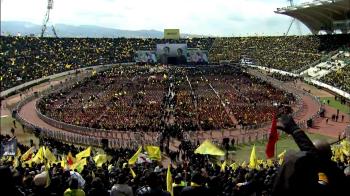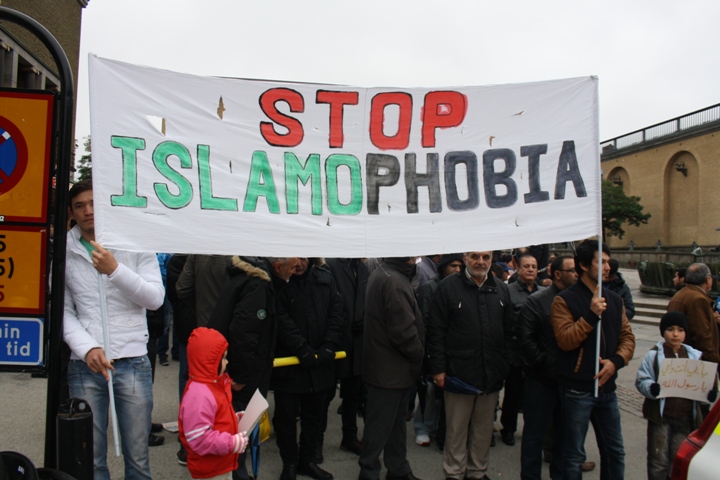Alwaght-The recent shooting of three American Muslim students in Chapel
Hill, North Carolina, has focused attention on anti-Muslim hatred in the US.
There are strong reasons for thinking the suspect, Craig Stephen
Hicks, was motivated by anti-Muslim animosity to murder Deah Barakat, 23, Yusor
Abu-Salha, 21, and Razan Abu-Salha, 19.
The FBI is now investigating the case as a possible hate crime, although
initial reports stated the murder may have been about a dispute over parking.
In 2011, a reporter spent a year travelling around the US
investigating anti-Muslim prejudice. In
a suburban restaurant in Houston, he saw a poster that perfectly captured the
nature of the Islamophobia problem. The
restaurant owner had used a photograph of a lynching in the early 20th century,
featuring a tree, a dead body hanging from a branch and a crowd of white people
in the foreground looking jubilant. In
place of the black victim of the original image, the face of a stereotypical
Arab was superimposed with the caption: “Let’s play cowboys and Iranians.”
It was a disturbing sight for the reporter. In the same neighborhood, he had heard
stories of teenagers beaten up at school simply for being Arab, of harassment
of mosque congregations and of death threats against Muslims aired on local
radio stations. It was also disturbing,
because racist imagery appeared to be a perfectly normal way to decorate a
restaurant. However, the image was also
revealing, because it shows anti-Muslim sentiment in the US is a part of a
longer racial history.
The poster’s caption played on the phrase “cowboys and Indians” and
was an implicit celebration of the genocide of America’s indigenous people by
European settlers, the first act in the racial history of the US and one that
continues to haunt an American culture obsessed with enemies at its frontiers.
Likewise, the use of a photo of a lynching ties its meaning to the
history of racial segregation after the abolition of slavery, and the ways that
violence was used to maintain white supremacy.
Anti-Muslim prejudice is the most recent layer in this history, a
reworking and recycling of older logics of oppression. From this perspective, Islamophobia, like
other forms of prejudice, should not be seen only as a problem of hate crimes
committed by lone extremists. The acts
of individual perpetrators can only be made sense of, if they are seen as the
product of a wider culture, in which glorifying racial violence is acceptable.
Not only the US but also the British Empire relied upon racist
ideology to maintain its authority, both domestically and in colonial settings,
and particularly in the face of resistance to its rule. Blacks and Asians from the colonies who
settled in Britain after the Second World War encountered the racism
imperialism had fostered there, persisting long after the British Empire itself
no longer existed.
Since the end of the Cold War, US foreign policy planners have
regarded the West Asia as their most troublesome territory, where resistance
seems to be especially strong against the US’s key regional ally, Israeli
regime. Large sections of the US
political and cultural elite have turned to racial ways of explaining resistance
to its authority. Rather than see the
Palestinian movement, for example, as rooted in a struggle against military
occupation and for human rights, it has been more convenient to think that
Arabs are inherently fanatical. In other
words, the problem is their Western culture, not us being Muslims.
Reported incidents of anti-Islamic crimes shot up 1,600% in 2001
compared with the number of similar incidents in 2000. More than 550 people were victims of
anti-Muslim crimes that year.
Though that rate of reported hate crimes against Muslims has not
continued, it has leveled off at a rate that is still much higher than it was
prior to the attacks of Sept. 11, 2001.
Prior to 2001, reported crimes against Muslims in the US averaged fewer
than 50 per year. In the years since,
that number has often been closer to 150.
Hate crimes against Islam made up about 13% of religiously motivated
crime in 2013.
Those reported numbers are likely much lower than the number of
actual incidents, as reported by Mark Potok, a senior fellow at the Southern
Poverty Law Center, a group that monitors hate crimes in the US The actual number of hate crimes in the
country is somewhere between 25-40% higher than what is reported by the FBI, he
said.
Some attribute the recent spike seen to a recent string of deadly
attacks in Paris and other locations by extremists claiming to represent Islam,
and Potok agreed.
“Anecdotally, I don’t have the slightest doubt that anti-Muslim
crime and hate speech is very much on the rise," Potok said. "That is a function of [extremists]
being on the news recently.”
If the murders in Chapel Hill turn out to be labeled a hate crime,
it will be the most horrific and public incident of an anti-Muslim crime in the
US in recent memory. However, it will
not be the only recent murder.
In December, an SUV allegedly driven by Ahmed Aden, a Somali
Christian ran over and killed Abdisamad Sheikh-Hussein, a 15-year-old Muslim
boy. The murder occurred outside a
Somali community center in Kansas City, where worshipers at the center had
recently told the police about an SUV painted with the message "Islam is
worse than Ebola" that was driving near the center. The story was covered by many known US
magazines, but did not generate the furor of the incident in Chapel Hill.
Recent days have also seen reports of anti-Muslim graffiti sprayed
on a school in Washington and a plot to blow up an Islamic center in Austin,
Texas.
As 2015 wears on, some say they expect to see an increased number
of hate crimes against Muslims in the US.
Kevin Barrett, a founding member of the Muslim-Jewish-Christian
Alliance for 9/11 Truth from Madison, and Maxine Dovere, a New York-based
reporter, discussed the murder of the three Muslim students in the US and the
way Washington is dealing with the rise in Islamophobic sentiments.
Barrett says hate crimes like the death of the Muslim youths in
North Carolina are the direct results of the Islamophobia campaign followed by
US main stream media in the aftermath of 9/11 attacks.
There is no doubt US is the main producer of the recent Islamophobia
scenario in the whole world, and this falls in its interest to keep its
neo-empire intact from any righteous resistance that may threaten its
entity. The US realized that Islam is a
religion that does not allow the oppressed to stand still without any action
towards the oppressor, and thereby it will be from US benefit to create a
monster from this religion in order to turn public opinion against every
Muslim.
Muslims in the US and worldwide face this challenge of Islamophobia
and must clearly present to the public opinion that the real Islam has nothing
to do with the extremist monster that US and the West created such as ISIS in
order to freak their people from Islam.
The Western people from their side should not look at the media with one
eye concentrating on what their devious masters are trying to show in order to
wash their brains, they must keep their view more open and unbiased towards
Islam and take a look at its original resources as did the Supreme Leader
Ayatollah Sayyed Ali Khamenei advised their youths recently with his known open
letter.



























